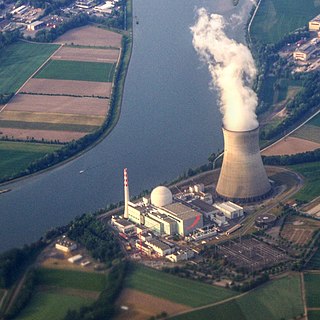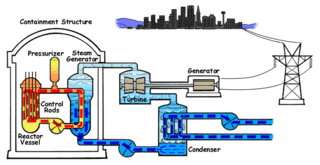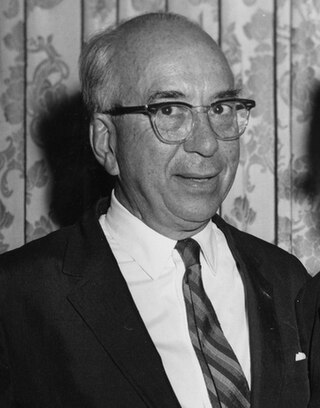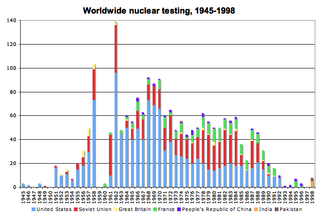
The CANDU is a Canadian pressurized heavy-water reactor design used to generate electric power. The acronym refers to its deuterium oxide moderator and its use of uranium fuel. CANDU reactors were first developed in the late 1950s and 1960s by a partnership between Atomic Energy of Canada Limited (AECL), the Hydro-Electric Power Commission of Ontario, Canadian General Electric, and other companies.

A nuclear reactor is a device used to initiate and control a fission nuclear chain reaction or nuclear fusion reactions. Nuclear reactors are used at nuclear power plants for electricity generation and in nuclear marine propulsion. Heat from nuclear fission is passed to a working fluid, which in turn runs through steam turbines. These either drive a ship's propellers or turn electrical generators' shafts. Nuclear generated steam in principle can be used for industrial process heat or for district heating. Some reactors are used to produce isotopes for medical and industrial use, or for production of weapons-grade plutonium. As of 2022, the International Atomic Energy Agency reports there are 422 nuclear power reactors and 223 nuclear research reactors in operation around the world.

Nuclear power is the use of nuclear reactions to produce electricity. Nuclear power can be obtained from nuclear fission, nuclear decay and nuclear fusion reactions. Presently, the vast majority of electricity from nuclear power is produced by nuclear fission of uranium and plutonium in nuclear power plants. Nuclear decay processes are used in niche applications such as radioisotope thermoelectric generators in some space probes such as Voyager 2. Generating electricity from fusion power remains the focus of international research.

Tritium or hydrogen-3 is a rare and radioactive isotope of hydrogen with half-life ~12.3 years. The nucleus of tritium contains one proton and two neutrons, whereas the nucleus of the common isotope hydrogen-1 (protium) contains one proton and zero neutrons, and that of a non-radioactive hydrogen-2 (deuterium) contains one proton and one neutron.

The United States Atomic Energy Commission (AEC) was an agency of the United States government established after World War II by the U.S. Congress to foster and control the peacetime development of atomic science and technology. President Harry S. Truman signed the McMahon/Atomic Energy Act on August 1, 1946, transferring the control of atomic energy from military to civilian hands, effective on January 1, 1947. This shift gave the members of the AEC complete control of the plants, laboratories, equipment, and personnel assembled during the war to produce the atomic bomb.

Nuclear fallout is the residual radioactive material propelled into the upper atmosphere following a nuclear blast, so called because it "falls out" of the sky after the explosion and the shock wave has passed. It commonly refers to the radioactive dust and ash created when a nuclear weapon explodes. The amount and spread of fallout is a product of the size of the weapon and the altitude at which it is detonated. Fallout may get entrained with the products of a pyrocumulus cloud and fall as black rain. This radioactive dust, usually consisting of fission products mixed with bystanding atoms that are neutron-activated by exposure, is a form of radioactive contamination.

In nuclear engineering, a neutron moderator is a medium that reduces the speed of fast neutrons, ideally without capturing any, leaving them as thermal neutrons with only minimal (thermal) kinetic energy. These thermal neutrons are immensely more susceptible than fast neutrons to propagate a nuclear chain reaction of uranium-235 or other fissile isotope by colliding with their atomic nucleus.

The Atomic Age, also known as the Atomic Era, is the period of history following the detonation of the first nuclear weapon, The Gadget at the Trinity test in New Mexico, on 16 July 1945, during World War II. Although nuclear chain reactions had been hypothesized in 1933 and the first artificial self-sustaining nuclear chain reaction had taken place in December 1942, the Trinity test and the ensuing bombings of Hiroshima and Nagasaki that ended World War II represented the first large-scale use of nuclear technology and ushered in profound changes in sociopolitical thinking and the course of technological development.

A scram or SCRAM is an emergency shutdown of a nuclear reactor effected by immediately terminating the fission reaction. It is also the name that is given to the manually operated kill switch that initiates the shutdown. In commercial reactor operations, this type of shutdown is often referred to as a "scram" at boiling water reactors (BWR), a "reactor trip" at pressurized water reactors and EPIS at a CANDU reactor. In many cases, a scram is part of the routine shutdown procedure, which serves to test the emergency shutdown system.

Nuclear propulsion includes a wide variety of propulsion methods that use some form of nuclear reaction as their primary power source. The idea of using nuclear material for propulsion dates back to the beginning of the 20th century. In 1903 it was hypothesized that radioactive material, radium, might be a suitable fuel for engines to propel cars, planes, and boats. H. G. Wells picked up this idea in his 1914 fiction work The World Set Free. Many aircraft carriers and submarines currently use uranium fueled nuclear reactors that can provide propulsion for long periods without refueling. There are also applications in the space sector with nuclear thermal and nuclear electric engines which could be more efficient than conventional rocket engines.

Lewis Lichtenstein Strauss was an American government official, businessman, philanthropist and naval officer. He was one of the original members of the United States Atomic Energy Commission (AEC) in 1946 and he served as the commission's chair in the 1950s. Strauss was a major figure in the development of nuclear weapons after World War II, nuclear energy policy and nuclear power in the United States.
The Army Nuclear Power Program (ANPP) was a program of the United States Army to develop small pressurized water and boiling water nuclear power reactors to generate electrical and space-heating energy primarily at remote, relatively inaccessible sites. The ANPP had several accomplishments, but ultimately it was considered to be "a solution in search of a problem." The U.S. Army Engineer Reactors Group managed this program and it was headquartered at Fort Belvoir, Virginia. The program began in 1954 and had effectively terminated by about 1977, with the last class of NPP operators graduating in 1977. Work continued for some time thereafter either for decommissioning of the plants or placing them into SAFSTOR. The current development of small modular reactors has led to a renewed interest in military applications.
Project Sherwood was the codename for a United States program in controlled nuclear fusion during the period it was classified. After 1958, when fusion research was declassified around the world, the project was reorganized as a separate division within the United States Atomic Energy Commission (AEC) and lost its codename.

Nuclear fuel is material used in nuclear power stations to produce heat to power turbines. Heat is created when nuclear fuel undergoes nuclear fission.

SNAP-10A was a US experimental nuclear powered satellite launched into space in 1965 as part of the SNAPSHOT program. The test marked both the world's first operation of a nuclear reactor in orbit, and the first operation of an ion thruster system in orbit. It is the only fission reactor power system launched into space by the United States. The reactor stopped working after just 43 days due to a non-nuclear electrical component failure. The Systems Nuclear Auxiliary Power Program reactor was specifically developed for satellite use in the 1950s and early 1960s under the supervision of the U.S. Atomic Energy Commission.

Fermi 1 was the United States' only demonstration-scale breeder reactor, built during the 1950s at the Enrico Fermi Nuclear Generating Station on the western shore of Lake Erie south of Detroit, Michigan. It used the sodium-cooled fast reactor cycle, in which liquid sodium metal is used as the primary coolant instead of typical nuclear reactor designs cooled by water. Sodium cooling permits a more compact core, generating surplus neutrons used to produce more fission fuel by converting a surrounding "blanket" of 238U into 239Pu which can be fed back into a reactor. At full power, it would generate 430 MW of heat (MWt), or about 150 MW of electricity (MWe).

The Department of Atomic Energy (DAE) is an Indian government department with headquarters in Mumbai, Maharashtra, India. DAE was established in 1954 with Jawaharlal Nehru as its first minister and Homi Bhabha as its secretary.

The application of nuclear technology, both as a source of energy and as an instrument of war, has been controversial.

Lawrence Randolph Hafstad was an American electrical engineer and physicist notable for his pioneering work on nuclear reactors and development of proximity fuzes. In 1939, he created the first nuclear fission reaction in the United States.
James Gwavas Beckerley II was an American nuclear physicist. He graduated with a Bachelor of Arts and a PhD in physics from Stanford University. He taught at Columbia University and Judson College in Burma. He became the director of classification of the United States Atomic Energy Commission in 1949, though resigned in 1954 due to his disagreement about security measures he thought were excessive. He served as editor of several journals, including the Annual Review of Nuclear Science and Nuclear Fusion.

















